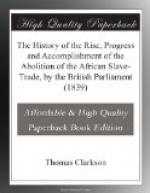In the middle watch, or between one and two next morning, George Ormond looked out of one of the port-holes, and called to Green, but received no answer. Between two and three, Paul Berry, a seaman, was sent down into the boat, and found him dead. He made his report to one of the officers of the ship. About five in the morning the body was brought up, and laid on the waist near the half-deck door. The captain on seeing the body when he rose, expressed no concern, but ordered it to be knocked out of irons, and to be buried at the usual place of interment for seamen, or Bonny Point. I may now observe, that the deceased was in good health before the punishment took place, and in high spirits; for he played upon the flute only a short time before Rodney asked him for the keys, while those seamen, who were in health, danced.
On hearing this cruel relation from George Ormond, who was throughout a material witness to the scene, I had no doubt in my own mind of the truth of it; but I thought it right to tell him at once that I had seen a person, about four weeks ago, who had been the same voyage with him and Peter Green, but yet who had no recollection of these circumstances. Upon this he looked quite astonished, and began to grow angry; he maintained he had seen the whole; he had also held the candle himself during the whole punishment. He asserted that one candle and half of another were burnt out while it lasted. He said also that, while the body lay in the waist, he had handled the abused parts, and had put three of his fingers into a hole, made by the double walled knot, in the head, from whence a quantity of blood and, he believed, brains issued. He then challenged me to bring the man, before him; I desired him upon this to be cool, and to come to me the next day, and I would then talk with him again upon the subject.
In the interim I consulted the muster-roll of the vessel again; I found the name of George Ormond; he had sailed in her out of Liverpool, and had been discharged at the latter end of January in the West Indies, as he had told me. I found also the names of Michael Cunningham and of Paul Berry, whom he had mentioned. It was obvious also that Ormond’s account of the captain of the Alfred being on board at the time of the punishment tallied with that given me at Bristol by an officer of that vessel, and that his account of letting down Peter Green into the boat tallied with that which Mr. Falconbridge, as I mentioned before, had heard from the king and the black traders in Bonny river.




